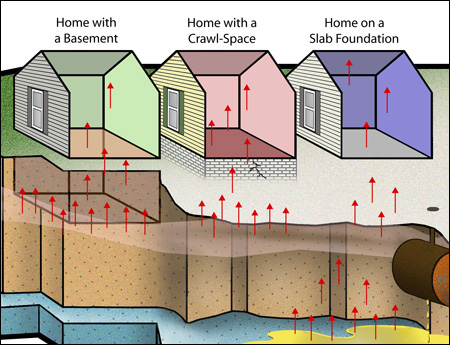What is Vapor Instrusion?
Vapor intrusion is a process in which chemical vapors from contaminated soil or ground water affect the indoor air quality in a building. Whenever chemicals are spilled on the ground or leak from an underground storage tank, they can soak into the soil or dissolve into the ground water and begin to spread. The contaminated soil or ground water can emit vapors that spread to areas occupied by buildings. Vapors can enter the buildings through cracks in basements, foundations, sewer lines, and any other type of opening. Occasionally, the vapors can increase to concentrations that may be harmful to human health. They can cause short-term discomfort, and long-term exposure may raise the risk of chronic diseases.

Volatile organic compounds from gasoline and chlorinated compounds from drycleaning and industrial operations are the most common chemicals associated with vapor intrusion. However, vapor intrusion itself is not common and is not usually a problem if the contamination is more than 100 feet away.
How to Investigate Vapor Intrusion
The interpretation of indoor air sampling results is often complicated by volatile organic compounds (VOCs) that are normally present within the home or building. These VOCs can come from household products. Sometimes hobbies or other activities within the home or building also create indoor air problems.
Since a variety of volatile organic compound sources are present in most homes and buildings, testing inside the home or building will not necessarily confirm that VOCs in the indoor air are from nearby VOC contamination. In most cases, the potential for vapor intrusion can be verified or ruled out by collecting soil gas samples or ground water samples near the contamination site. In some cases, it is necessary to sample immediately beneath the home or building or in the living space.
Usually vapor intrusion concerns are identified during the investigation of contamination of neighboring sites. If strong petroleum or other chemical odors are noticeable inside a home, it may be advisable to leave the home or call the local fire department.
How to Correct Vapor Intrusion Problems
The most common solution to vapor intrusion problems is the installation of a vapor intrusion mitigation system. These systems are similar to radon remediation systems, and they vent contaminants from the soil below the foundation or basement outside before they can enter the building. A vapor intrusion mitigation system is very simple and uses minimal electricity.
Additional Information and Guidance
- IDEM’s Vapor Intrusion Definitions page lists applicable terms and definitions.
- IDEM’s Remediation Closure Guide (Waste-0046-R2, available on the IDEM Effective Nonrule Policies page) provides additional vapor intrusion information. Refer to Section 5, Section 10, and Appendix A.
- IDEM’s Vapor Remedy Selection and Implementation [PDF] supplements the Remediation Closure Guide and provides guidance for choosing appropriate remedies for vapor intrusion sites.
- The U.S. Environmental Protection Agency’s Vapor Intrusion website is also a useful resource.
